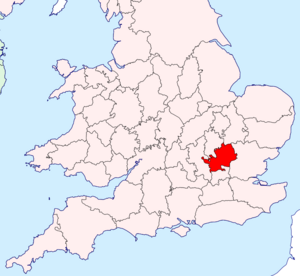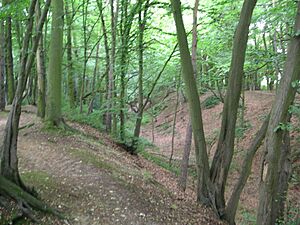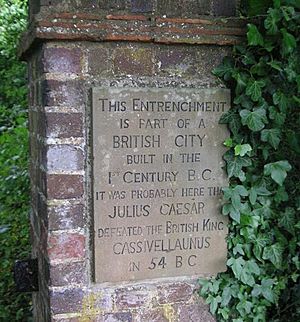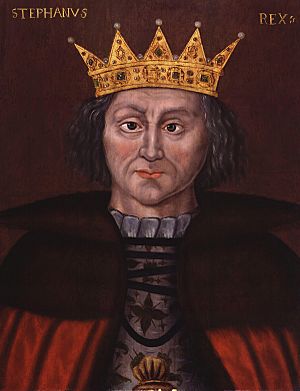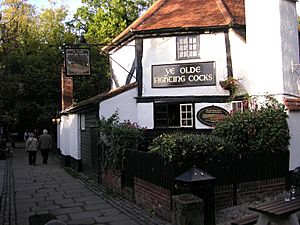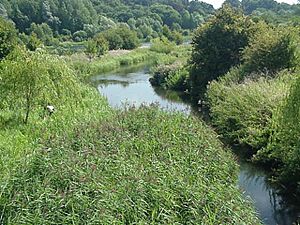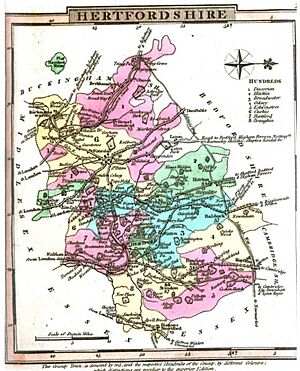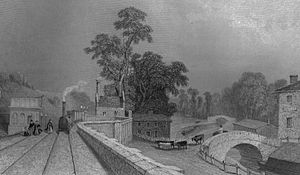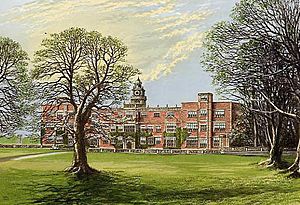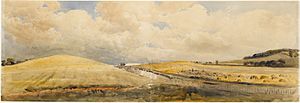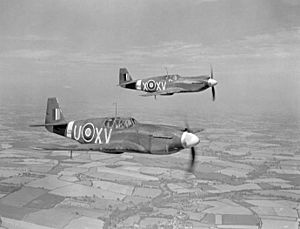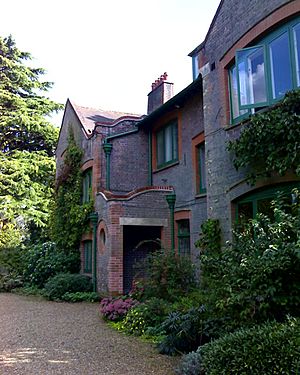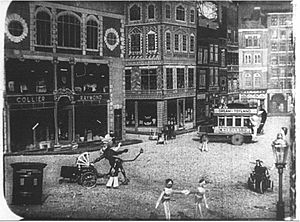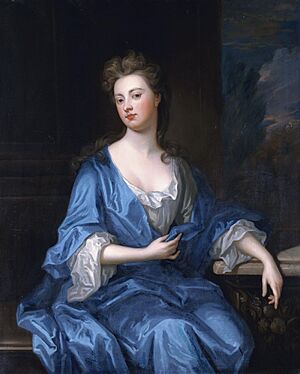History of Hertfordshire facts for kids
Hertfordshire is a county in England. It was formed during the wars between the Norse (Vikings) and Saxons in the 800s. The county grew because of trade with London, which is a very large city. Hertfordshire is a land-locked county, meaning it has no coast. It was even the place where the English Parliament met several times!
Hertfordshire used to be known for making beer and paper. Later, it became important for building aircraft. Today, it has many different industries like medicine, finance, and film-making. More than 1 million people live in Hertfordshire now. Most people work in services, industry, and trade. Very few people (less than 2,000) work in farming, forestry, or fishing.
Hertfordshire is one of England's oldest counties, first mentioned in the early 900s. Its growth has always been linked to London, which is right on its southern border. London needs huge amounts of supplies every day. Hertfordshire became rich because many old Roman roads, the Grand Union Canal, and other waterways pass through it, bringing goods to the capital. In the 1800s, train lines were built, connecting London to the north through Hertfordshire.
Even though Hertfordshire is often politically conservative today, it has a history of rebellions against the king. These include the Peasants' Revolt and parts of the English Civil War. Many famous writers, from Geoffrey Chaucer to Beatrix Potter, have connections to Hertfordshire. Several British prime ministers were also born or grew up here.
The county has many abandoned villages. This might be because of poor harvests on difficult land and the Black Death, a terrible disease that hit Hertfordshire in 1349.
Contents
Early Human History in Hertfordshire
The oldest signs of people living in Hertfordshire are flint tools found in Rickmansworth. These tools are about 350,000 years old! This was long before Britain became an island.
People have likely lived in this area for about 12,000 years, since the Middle Stone Age (Mesolithic period). Evidence of early settlements has been found in Ware, making it one of Europe's oldest continuously inhabited places. People continued to live here through the New Stone Age (Neolithic period). Signs of settlements, enclosures, and even an unusual dog cemetery have been found.
The population was quite small during the Neolithic and early Bronze Age. This might be because the soil was heavy and not well-drained. However, near present-day Ware and Hertford, there's evidence of more people. They lived in round huts and farmed the land at a place called Foxholes Farm.
Iron Age Tribes and Settlements
During the Iron Age, a Celtic tribe called the Catuvellauni lived in Hertfordshire. Their main settlement was Verlamion, near today's St Albans. Other important Iron Age towns in Hertfordshire included Cow Roast, Wheathampstead, Welwyn, Braughing, and Baldock. Hertfordshire also has several Iron Age hill forts. The largest in Eastern England is Ravensburgh Castle in Hexton.
Many Iron Age burial sites have been found in Hertfordshire. This makes it a very important place for studying the Iron Age. The large number of sites shows that many people lived here just before the Romans arrived.
Roman Invasion and Life in Hertfordshire
When the Romans first tried to invade Britain in 55 BCE, the Catuvellauni were the largest British tribe. Their name means "Expert Warrior." The Roman leader Caesar said that "Cassivellaun" (Cassivellaunus) was the leader of the Britons. Cassivellaunus's main camp was near Wheathampstead in Hertfordshire.
In Caesar's second invasion in 54 BCE, Cassivellaunus led the British defense. The Romans surrounded him at Wheathampstead. The Catuvellauni had to surrender, partly because another tribe, the Trinovantes, switched sides. However, Caesar returned to Rome without leaving any soldiers behind.
Cunobelinus became king of the Catuvellauni around 9 or 10 CE. He ruled for about 30 years. He conquered so much of Britain that a Roman writer called him "King of Britain." He built Beech Bottom Dyke, a defensive earthwork, near St Albans. This might be connected to another Iron Age defense, the Devil's Dyke, near Cassivellaunus's camp in Wheathampstead.
The Romans defeated the Catuvellauni again in 43 CE. This time, they left soldiers in Britain. The Roman town, built in 49 CE, was called Verulamium. Alban, a Roman army officer, became Britain's first Christian martyr. He died in the 200s or 300s and gave his name to the modern town of St Albans. Verulamium became one of Roman Britain's most important cities. It was the third-largest and the only one allowed to govern itself.
Even with strong defenses, Boudica burned Verulamium in 61 CE. The city was rebuilt with new defenses. It was lived in until the 400s.
Several Roman Roads run through Hertfordshire, including Watling Street and Ermine Street. The ancient path, the Icknield Way, also crosses the county. These were three of the four main roads in medieval England. They were still the most important routes over a thousand years later.
Hertfordshire in the Early Middle Ages
After the Anglo-Saxon invasion of Britain, the Hertfordshire area was part of the Kingdom of Mercia and the Kingdom of Essex. The first national meeting of the English Church, the Synod of Hertford, happened on September 26, 672 or 673. At this meeting, they decided how to calculate the date of Easter. It also ended the conflict between the Celtic Church and the Roman Church.
King Offa of Mercia (who died in 796) built a church in Hitchin. It burned down in 910 CE, and the monks moved to St Albans. Offa defeated Beornred of Mercia near Hitchin. He also founded St Albans Abbey.
How Hertfordshire County Began
The name Hertfordshire (Saxon "Heorotfordscir") was first used in 866. The county's real start was in the 900s. King Edward the Elder built two fortified towns called burhs in Hertford in 912 and 913.
In the late 800s, Hertfordshire didn't exist as a county. It was on the front line of the war between the Saxons and the Norsemen (Vikings). After the Saxon victory in 878, King Alfred the Great and Norse King Guthrum the Old divided England. The border between their lands split what would become Hertfordshire almost in half. This border ran along the River Lea and then along Watling Street. The land that is now Hertfordshire was partly in the Kingdom of Essex (under Norse control) and partly in the Kingdom of Mercia (Saxon).
Alfred also built weirs (small dams) on the River Lea at Hertford and Ware. This was probably to stop Viking ships from coming up the river. King Edgar the Peaceful is believed to have made Hertford the capital of the surrounding area between 973 and 975 CE.
Hertfordshire in the Middle Ages
Alfred died in 899. His son Edward the Elder worked with his son-in-law, Æthelred, and daughter, Æthelflæd, to take back parts of southern England from the Norse. During these campaigns, Edward built the two burhs in Hertford. Anglo-Saxon Hertford was an example of early town planning with its organized rectangular street pattern.
Coins were made in Hertford during this time. Kings like Edward the Martyr, Æthelred the Unready, and Knut the Great had coins minted there. Most of these coins have been found in Europe or Scandinavia. This suggests they were used to pay the Danegeld, a tax paid to the Vikings.
The St Brice's Day massacre in 1002 likely started in Welwyn. This was a planned killing of Norse people in England. King Sweyn Forkbeard of Denmark's sister, Gunhilde, was killed. He invaded England the next year in revenge. Forkbeard's attack lasted ten years. He became King of England in 1013 but died five weeks later.
Norman Conquest and Growth
After the Norman Invasion, Edgar the Ætheling (the heir to the English throne) surrendered to William the Conqueror at Berkhamsted. William gave the manor of Berkhamsted to his half-brother, Robert. It later passed to King Henry I and is still owned by the royal family.
The Domesday Book, finished in 1086, listed 168 settlements in Hertfordshire. The county's population grew quickly until the Black Death arrived in 1349. The Norman church at St Albans Abbey was finished in 1088.
Hertfordshire had a complicated relationship with the King. Most of the county was privately owned, not by the King. The first Earl of Hertford, Gilbert de Clare, received his title in 1138. His grandson, Richard de Clare, sided with the barons against King John during the First Barons' War. Richard was one of the 25 barons who swore to enforce Magna Carta.
Thomas Becket, who became Archbishop of Canterbury in 1161, held Berkhamsted Castle from 1155 to 1163. King Henry II celebrated Christmas there in 1163.
Around this time, castles were built in Great Wymondley, Pirton, and Therfield. Watford was founded in the 1100s, likely because of a market and church set up by the Abbot of St Albans.
Magna Carta and Conflicts
The first version of Magna Carta was written at St Albans Abbey in 1213. It included important ideas still used today, like habeas corpus (the right to be brought before a court). Two years later, King John was in St Albans when he heard about the Archbishop of Canterbury's suspension.
Although John agreed to Magna Carta, he didn't follow it. Hertfordshire became a main battlefield in the civil war that followed. In December 1216, during the First Barons' War, Hertford Castle surrendered after a siege by Prince Louis of France. Berkhamsted Castle surrendered around the same time.
In 1261, King Henry III held parliament in the county. In 1295, another parliament was held in St Albans. In 1299, King Edward I gave Hertford Castle to his wife, Margaret of France, on their wedding day.
Hertfordshire's soil is mostly clay. It's rich but heavy, making it hard to grow crops with medieval tools. However, the county grew good barley, which later became important for making beer. Hertfordshire grew more through trade than through farming.
The county was quite urban for medieval times. Trade grew steadily from the 1100s until the Black Death. In the 1200s, Hertfordshire traded butter, cheese, meat, and leather. Much of this went to London. The county also developed inns and services for travelers.
The Knights Templar built Baldock around 1140. By 1185, Baldock had 122 tenants and skilled craftspeople. King John granted the Knights a fair and market in Baldock in 1199.
England's Only Pope
Nicholas Breakspear, the only Englishman ever elected Pope, was born on a farm in Bedmond or Abbots Langley in Hertfordshire, probably around 1100. He was baptized in Abbots Langley. He was elected Pope on December 2, 1154, and took the name Adrian IV. He died in 1159.
Late Middle Ages in Hertfordshire
In 1302, King Edward I gave Kings Langley to the Prince of Wales. King Edward II's friend, Piers Gaveston, loved the palace at Kings Langley and was buried there after his death in 1312. Edmund of Langley, the founder of the House of York, was born and died in Kings Langley.
Richard of Wallingford, a mathematician and astronomer, became Abbot of St Albans in 1326. He is considered the father of modern trigonometry.
Hertford Castle was used as a prison for important captives during the Hundred Years' War. This was a series of wars between England and France that lasted 116 years. Queen Isabella was imprisoned there in 1330. King David II of Scotland and his queen were imprisoned there in 1346. King John II of France was held there in luxury in 1359.
The Black Death and Peasants' Revolt
The Black Death in the mid-1300s greatly reduced Hertfordshire's population. It probably fell by 30% to 50%. It took until the 1500s for the population to recover. This led to many villages being abandoned, especially in the north and east where farming was difficult. However, the people who survived became richer. Fewer workers meant they could demand higher wages and better conditions. These changes led to the Peasants' Revolt in 1381, in which people from Hertfordshire were very involved.
After the revolt leader, Wat Tyler, was caught and killed, King Richard II went to St Albans to calm the rebels. Richard's body was buried at Kings Langley church in 1400, but later moved to Westminster Abbey.
King Henry IV temporarily moved his government to St Albans early in his reign. King Henry V married Catherine of France in 1420 and gave Hertford Castle to her.
Wars of the Roses Battles
Three important battles of the Wars of the Roses took place in Hertfordshire. The First Battle of St Albans on May 22, 1455, was the first major battle. Richard of York defeated the Lancastrians, killed their leader, and captured King Henry VI. The Lancastrians recaptured the King at the Second Battle of St Albans on February 12, 1461.
The Battle of Barnet took place on April 14, 1471. After some confusion in the morning mist, the Lancastrians won the battle. The Kingmaker was captured and executed.
England's oldest surviving pub is in Hertfordshire. Ye Olde Fighting Cocks in St Albans was rebuilt in 1485. Some of its foundation stones are even older, possibly from the 700s.
Early Paper and Printing
One of England's first three printing presses was in St Albans. England's first paper mill, owned by John Tate, was in Hertford from 1494. King Henry VII visited it twice.
Renaissance in Hertfordshire
The long peace during Queen Elizabeth I's reign and problems in Europe helped England's trade grow. London became a powerful center, and Hertfordshire's trade benefited.
In November 1524, Catherine of Aragon held court at Hertford Castle. In 1547, King Edward VI gave his sister Mary the manor and castle of Hertford.
Under Queen Mary I, three Protestants were burned at the stake in Hertfordshire for their beliefs. William Hale, Thomas Fust, and George Tankerville were executed in Barnet, Ware, and St Albans. In 1554, Queen Mary granted the town of Hertford its first official document (charter).
Queen Elizabeth I lived at Hatfield Palace as a girl. When the plague hit London, she held parliaments at Hertford Castle in 1564 and 1581. The law courts also moved to St Albans. Hertfordshire soldiers were praised for their efficiency during her reign. In 1588, for the war with Spain, the county sent many soldiers to defend the Queen and London. The Arms of Hertfordshire were granted the next year.
King James I often visited Hertfordshire. He built Theobalds Park, enclosing a large area of southern Hertfordshire with a wall. He also helped create the New River, an artificial waterway that brought water to London.
James I loved dogs and built a huge kennel and dog-yard in Royston. He spent a lot of time there. Once, his favorite dog, Jowler, returned with a note tied to his collar asking the King to return to London because the local people were running out of supplies.
English Civil War Impact
During the civil war, Hertfordshire mostly supported Parliament. St Albans was a strong supporter of Parliament. In 1645, a dozen men from Oliver Cromwell's army were hanged for harming the people of the county.
In 1647, the parliamentary army, still unpaid, camped near Royston. They wrote to Parliament demanding their pay. This led to a clash between Cromwell's army and a group called the Levellers near Ware. Cromwell captured and imprisoned the Levellers' leaders.
After the Great Fire of London, many children were sent to Hertfordshire. In 1683, there was a plot to kill Charles II and his brother at Rye House in Hertfordshire. The plot failed, and it led to the punishment of many Whig leaders.
Modern Hertfordshire History
In the last two centuries, Hertfordshire's population has grown ten times larger. Around 1800, it was about 95,000. By 2001, it was over 1 million. In the 1700s, brewing became an important industry.
Smallpox broke out in Hertford prison in 1729 and spread to the town. The next year, smallpox killed 158 people in Hitchin. The River Lea was improved in 1739, making it navigable as far as Ware. Locks were built. By 1797, the Grand Junction Canal (now the Grand Union Canal) was being built. Its highest point is the Tring Summit in Hertfordshire. Canals allowed much more goods to be transported than wagons.
Hertfordshire also provided soldiers for wars. In 1756, money was paid to inns in Ware for troops staying there during the Seven Years' War. In 1794, the Hertfordshire Yeomanry Cavalry Regiment was formed.
In 1795, a report said Hertfordshire was "justly deemed the first and best corn county in the kingdom." This shows how better farming techniques helped farmers work the county's heavy soils.
The amount of paper records for Hertfordshire in the 1800s and 1900s is huge. Many of these documents were written or printed on paper made locally. Paper-making became a major industry alongside brewing.
In 1809, John Dickinson bought Apsley Mills in Hemel Hempstead for his new paper-making machine. By 1825, Apsley and Nash Mills were using steam power to make paper. Dickinson patented silk thread paper in 1829, used for government bonds. He built Croxley Mills near Rickmansworth in 1830.
In 1840, the Uniform Penny Post started. Dickinson made paper for the stamps. By 1900, his company had large glass houses in the Cheshunt area.
Rothamsted Research, one of the world's oldest agricultural research centers, is in Harpenden. It was founded in 1843 by a fertilizer inventor.
The 1800s were also busy for the military. Ten groups of Volunteer Infantry were formed in 1803. In 1804, the clock tower in St Albans signaled news of the Battle of Trafalgar by semaphore. The Duke of Wellington was honored in St Albans after Napoleon's defeat in 1814. Cecil Rhodes, who founded De Beers and Rhodesia (now Zimbabwe), was born in Bishops Stortford in 1853. His house is now a museum.
The first branch railway line in England, the Aylesbury one, opened in 1839. It had a station in Hertfordshire. Another rail line grew from London towards Cambridge, reaching Broxbourne in 1840. A branch to Hertford opened in 1843. The first Hatfield train crash happened on Boxing Day, 1870. The London Underground reached Rickmansworth in 1887.
Twentieth Century Developments
The two famous "garden cities" of Letchworth and Welwyn were key to town planning in England. The first Garden City Company formed in 1903. By 1914, Letchworth had about 10,000 people. Welwyn Garden City was officially founded on April 29, 1920.
In the First World War, the Hertfordshire Yeomanry went to Egypt in September 1914. The 1/1st Hertfordshire Regiment fought in France and Belgium. Two Victoria Crosses (the highest military award) were given to Hertfordshire men in 1916. Lieutenant William Leefe Robinson shot down the first German airship of WWI over Cuffley.
With the start of the Second World War in September 1939, the 1st and 2nd Battalions of the Hertfordshire Regiment were called to action. Hertfordshire was important for aircraft manufacturing. De Havilland designed their Mosquito in Hatfield and built them at Leavesden, along with Halifax bombers.
Many RAF pilots trained at Panshanger. From 1940, No. 2 (AC) Squadron was based at RAF Sawbridgeworth. They flew reconnaissance missions over Europe. About 4,000 bombs, 107 V-1 flying bombs, and 47 V-2 rockets fell on Hertfordshire during the war. American bombers also flew missions from RAF Nuthampstead.
Post-War Changes
After the war, Stevenage was the first town to be redeveloped under the New Towns Act 1946. Hatfield remained connected to the aircraft industry. About 10% of England's aircraft workers were in Hertfordshire in the 1960s. The de Havilland Comet jet was developed in Hatfield.
The London Government Act 1963 created a larger Greater London in 1965. It took Barnet from Hertfordshire, but the county gained Potters Bar and South Mimms. The county's borders were changed again in 1972, when Royston became fully part of Hertfordshire. In 1993, Elstree also became fully part of Hertfordshire.
During the Second World War, sculptor Henry Moore moved to Perry Green after his home was bombed. The Henry Moore Foundation still operates from the village.
Hertfordshire changed a lot in the late 1900s. In 1992, the aircraft manufacturing site in Hatfield closed. At the start of the 1900s, 83% of workers were in farming. By the end, less than 1% were. Only one brewery, McMullens, is still open. Today, Hertfordshire is a center for services and administration. Many important companies have their main offices here. Research and development are growing, especially for Glaxo and at the University of Hertfordshire.
On October 17, 2000, a major train crash happened in Hatfield. The company Railtrack faced much criticism and had to pay over £700 million in compensation. It went out of business in 2002.
The fire of December 11, 2005, at Buncefield, Hemel Hempstead, was a huge disaster. It was called "possibly the largest in peacetime Europe." About sixty million gallons of petrol burned. The largest explosion was like a small earthquake. Smoke darkened the skies for two days before the fire was put out.
In 2011, the census recorded only 1,878 workers in farming, fishing, and forestry in Hertfordshire. This shows a long decline in these industries.
Conservation Efforts in Hertfordshire
Hertfordshire has more listed buildings and village greens from before 1700 than Greater London. For example, many Grade II* listed buildings in Hertfordshire fall into this category. All ten District (or Borough) Councils have special conservation areas.
Famous Authors from Hertfordshire
Jane Austen (1775–1817) wrote about Hertfordshire. Her famous novel Pride and Prejudice is set in a fictional Hertfordshire. Sir Francis Bacon (1561–1626), a writer and Lord Chancellor, lived near St Albans. J. M. Barrie (1860–1937) based his character Peter Pan on a friend's son after visiting their family in Berkhamsted.
John Bunyan (1628–1688), author of Pilgrim's Progress, preached widely in Hertfordshire. Geoffrey Chaucer (c. 1343 – 1400), a famous poet, worked at Berkhamsted Castle in 1389. Charles Dickens (1812–1870) often visited Hertfordshire, and parts of his novels are set there. Nobel Prize-winning playwright George Bernard Shaw lived in Hertfordshire until he died in 1950.
Film-making in Hertfordshire
Hertfordshire was home to the early British filmmaker Arthur Melbourne-Cooper, born in St Albans in 1874. He helped create the first British 35mm moving picture camera. In 1908, Cooper opened the first permanent cinema in Hertfordshire, the Alpha Picture House in St Albans. This cinema operated for 87 years and has recently been restored.
Elstree Studios nearby has become very famous. Major films like the first two Star Wars movies, Indiana Jones, and Superman were made there. British TV shows like Dancing on Ice and Who Wants to Be a Millionaire? are also filmed there. Parts of the Harry Potter film series were made at Leavesden Film Studios.
Important People from Hertfordshire
Æthelgifu was a Christian Saxon noblewoman in the late 980s. Her will is an important document for studying the country. It shows she had three large estates in Hertfordshire. She left much of her land to the monks of St Albans.
Sarah Churchill, one of the most influential women in English history, was born in St Albans in 1660. She married the Duke of Marlborough and became a close friend of Queen Anne. She became very rich and built Blenheim Palace. Winston Churchill and Diana, Princess of Wales, were both her descendants.
A new title, the Earl of St Albans, was created in 1628. Later, Charles Beauclerk, the son of King Charles II, was made Duke of St Albans in 1684. This title still exists today.
Robert Arthur Gascoyne Talbot Cecil, the Marquess of Salisbury, was born and died at Hatfield House. He became the prime minister three times and foreign secretary four times. William Lamb, another prime minister, lived in Hertfordshire and died at Brocket Hall.
After the Local Government Act 1888, the first county councillors in Hertfordshire were elected on January 17, 1889.
Arthur Balfour, though born in Scotland, was educated in Hertfordshire. He served as a Member of Parliament for Hertford before becoming prime minister in 1902. He was the first prime minister to own a car. He later served as foreign secretary, and his Balfour Declaration was important in the lead-up to the creation of Israel.
|


